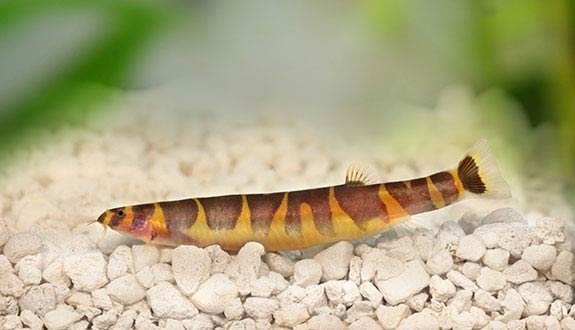

Alternative species (click on the thumbnail to see the card)
Names
Scientific name
Pangio kuhlii
Acanthophthalmus Kuhlii meyersi
Acanthophthalmus fasciatus
Cobitis kuhli
Pangio fasciatus / semicincta / sumatrana
Common name
Kuhli loach
Coolie loach
Slimy loach
Origin

Origin: Thailand, Malaysia, Indonesia
Biotope: Asian
Dimorphism

Females are larger (not very apparent)
Group

Cobitidae
Volume

120 L / 26 imp gal / 32 US gal
Parameters

T°: 24 to 28°C or 75 to 82°F
pH: 6.5 to 7
Hardness: 2 to 8°dGH
Difficulty

Easy
Size

8 to 15 cm (3 to 6")
Longevity

10 to 15 years
Living zone

Depth
Individuals

6
Food
How to feed the Kuhli loach?
Food
How to feed the Kuhli loach?
This omnivorous fish will accept all forms of food. Its preference for vaseworms is very clear! Do not hesitate to supplement your diet with vegetable supplements.
Give it its meal rather in the evening because it is a nocturnal fish.
Behavior
What kind of behavior does the Kuhli loach have?
Behavior
What kind of behavior does the Kuhli loach have?
It is a very sociable species with its own species as with all fish. These fish must imperatively live in a shoal of 6 to 10 individuals at least. Moreover, they become very shy if they lack congeners or if the aquarium is too "naked". The Kuhli likes to rest in groups.
It is a nocturnal species that will not activate until evening.
Cohabitation
Who can live with the Kuhli loach?
Cohabitation
Who can live with the Kuhli loach?
A community aquarium is accepted (independent, it does not worry about other inhabitants). However, the aggressive behavior of some species can annoy the Kuhli (like the cichlids that usually attack them).
Therefore, prefer rather peaceful roommates. For example, opt for Trichopsis, Sundadanio, Boraras, Barbs, small Rasbora, Sphaerichthys or Kottelatlimia.
Breeding
How to breed the Kuhli loach?
Breeding
How to breed the Kuhli loach?
No reliable data to date to trigger spawning for sure. Indeed, it seems that atmospheric changes come into play.
Note that sexual maturity is reached only when the fish is 2 or 3 years old.
Place males and females in a laying aquarium at least 60 cm or 23 inches tall. Generally, the female lays on the surface and the eggs stick on the plants or on the ground while falling. The laying can count between 300 and 500 light green eggs.
After laying, remove the parents and place the breeding aquarium in the dark. The incubation lasts between 24 and 48h.
Fry food: infusoria.
Its aquarium
Which aquarium for the Kuhli loach?
Its aquarium
Which aquarium for the Kuhli loach?
Its aquarium will necessarily have a substrate of fine sand because the Kuhli burrows entirely in the ground during the day. A coarser gravel can stress, hurt and inhibit the natural behavior of your fish.
Plan for rich vegetation and lots of hiding places. For example, the Kuhli is very fond of areas shaded by roots.
Filtration side, prefer a light current and a small eddy on the surface of your aquarium.
Note that the Kuhli can live in the submerged part of an aquaterrarium, provided that it meets the above characteristics.
It may happen that the Kuhli jumps out of its tank, especially when it has just arrived in a new environment. Remember to put a lid on your installation.
Good To know
Find all additional information!
Good To know
Find all additional information!
Robust and not very sensitive to diseases, it is a fairly resistant fish.
The Kuhli can be placed as a groundfish in a large aquaterrarium.
Tendency to be active in the evening and at night.
It has barbels and a special organ connecting the swim bladder to the auditory system: the Weber apparatus. This organ can amplify sounds.
Yours photos!
Comments
Sort by:
Please login to post comments

